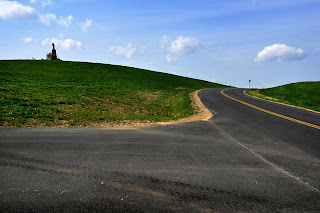 |
| Fork in the Road |
As an art major and teacher, the visual elements were considered the building blocks of art. All art, be it drawing or painting, sculpture or photography, is made up of these elements. This series will, however, approach the visual elements from the perspective of the contemplative photographer not as a graphic designer...not through their manipulation but through their implications. In painting and sculpture and all of the visual arts except photography, the artist is in charge of creating and manipulating the visual elements. In photography we don't create the elements, we discover them in the world around us. Our main "control" is how we choose to frame what we see. It is a very different process.
What are some of the ways line speaks to those of us who use photography as part of our contemplative practice? First of all, line is directional. Your eye follows a line and it can lead you in all sorts of directions. By following a line you create movement in the otherwise static image. The photograph above has several line elements. Three of them curve gently and to the right. They lead your eye into the distance. One pair of lines, however, the broken black ones on the bottom, force you to look to the left. They are opposing line elements that try to pull your eye away from the others. By framing the photograph so that the lines emerge from the lower right, I've emphasized their importance in the image.
Lines themselves, have a symbolic power of suggestion. Vertical lines are up lifting while horizontal lines are more static and calm. Curved and zig zag lines create a greater sense of movement. Even the thickness or thinness of a line adds to its impact. All can enhance the metaphor for the contemplative photographer but in the end the metaphor is related to the context of the image not merely the lines themselves.
In the image of the two roads above, the metaphor is not obvious until you know that the road on the right is the road that leads you by the Abbey of Gethsemani in Kentucky and the road on the left, the road with the black lines that are pulling you away from the main road, is the driveway of the Abbey. There is a wealth of reflection I could do on this image around my experience at the Abbey. I photographed this otherwise unremarkable scene for that metaphoric possibility. Those lines were the focal point for me that added to and expanded the metaphor...they were not the metaphor themselves.
Whenever I've lectured on contemplative photography I've urged people to develop their own symbol system to aid them in reflecting on their images. Lines have some universal implications (pick up any good book on design and you can read all about it...here is a link to a general discussion of the visual elements) but it matters most what they mean to you. Since our photographs are not meant to influence another persons perception of our work, only illuminate out own meditations on the image, then how the visual elements are perceived by you is all that matters.
No comments:
Post a Comment